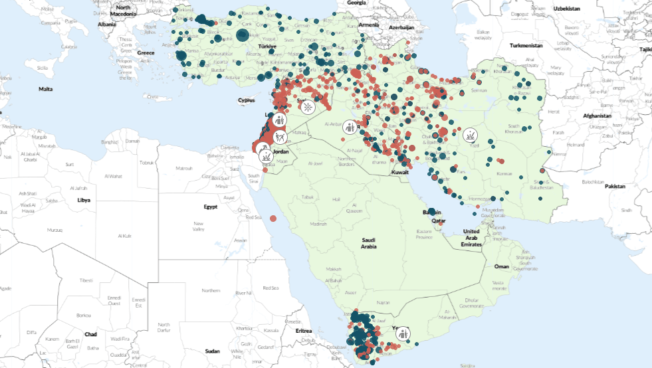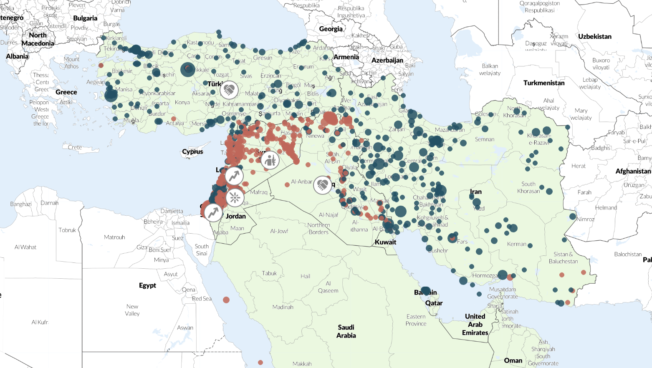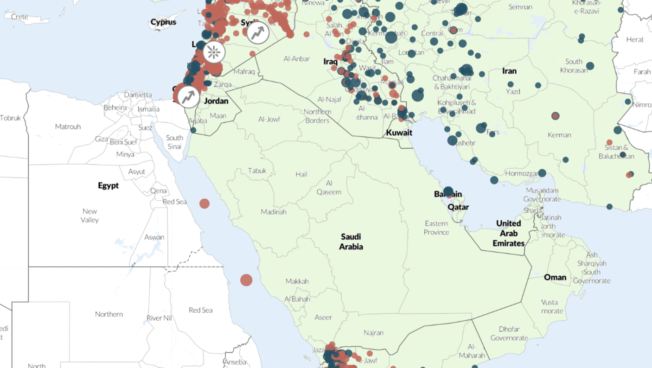Regional Overview
Middle East
May 2025
Posted: 8 May 2025
In this Regional Overview covering April 2025
- Gaza: Violence intensifies amid an expanding Israeli buffer zone
- Lebanon: Sporadic Israeli attacks on Beirut persist
- Northern Syria: Violent confrontations between regime forces and SDF decline after a peace deal is signed
- Southern Syria: Sectarian tensions rise between the government and Druze militias
- Yemen: US strikes skyrocket amid continued Houthi attacks in the Red Sea and against Israel
Gaza: Violence intensifies amid an expanding Israeli buffer zone
In April, violence in Gaza escalated with renewed clashes between Hamas and Israeli forces and an intensification of Israeli airstrikes. Israel launched its most extensive and intense airstrike campaign on Gaza since December 2023: ACLED records 617 airstrike events in April — an increase of 70% compared to March. Amid this escalation, Hamas fired 10 rockets into southern Israel on 6 April, in its most significant rocket attack on Israel since October 2024. While five were intercepted, the remainder caused extensive property damage in the coastal city of Ashkelon, injuring one Israeli civilian.
After weeks without direct engagements since the ceasefire breakdown, Hamas ambushed Israeli forces near Beit Hanoun on 19 and 24 April, killing two soldiers. These attacks, staged in the Israeli-held buffer zone along Gaza’s northeast border, highlight Hamas’s continued ability to launch lethal attacks on Israel’s positions in Gaza, exposing potential long-term vulnerabilities.
The renewed fighting came as Israel expanded the buffer zone in southern Gaza in April, capturing the Morag Corridor between Rafah and Khan Yunis,1Emanual Fabian, “IDF advances in Gaza, expands buffer zone to pressure Hamas, but no fighting taking place,” Times of Israel, 9 April 2025 effectively splitting southern Gaza.2Yaniv Kubovich and Rawan Suleiman, “Defense Chief Declares Rafah Part of ‘Israeli Security Zone,’ Expansion of Gaza Offensive,” Haaretz, 12 April 2025 Ahead of the advance, 97% of Rafah’s population was ordered to evacuate, displacing over 140,000 Palestinians.3European Commission, “Statement by Commissioner Lahbib on the forced displacement orders in Rafah, Gaza,” 4 April 2025 ACLED records 87 incidents — up from seven in March — of Israeli military forces razing land and employing controlled explosions to blow up buildings and residential homes in southern Gaza, likely linked to the buffer zone’s expansion. Israeli forces also advanced in Gaza City’s al-Darraj, al-Tuffah, and al-Shujaiyya neighborhoods.
While ceasefire negotiations continued throughout the month, both Hamas and Israel have denied any breakthroughs. Hamas remains opposed to “partial or temporary truce proposals,” while Israel insists on Hamas’s disarmament, which the group opposes.4Lazar Berman and Nurit Yohanan, “Israeli official: Reports of breakthrough in hostage-ceasefire talks ‘inaccurate,’” The Times of Israel, 29 April 2025 Israel’s recent cabinet approval of a plan to “conquer” Gaza and maintain a “sustained presence,” which would entail the launch of an intensified offensive, Operation Gideon’s Chariots, signals a continued expansion of military operations and further diminishes prospects for a permanent ceasefire.5Jason Burke, “Netanyahu says new offensive in Gaza focused on consolidating seizure of territory,” The Guardian, 5 May 2025
For more information, see ACLED Gaza Monitor.
Lebanon: Sporadic Israeli attacks on Beirut persist
In April, political violence in Lebanon decreased by 50%, following the March flare-up with Israel sparked by unclaimed rocket attacks, likely fired by Hamas-affiliated individuals from Lebanese territory.6L’Orient Today, “Lebanese Army arrests new Hamas-affiliated suspect for rockets fired in March,” 4 May 2025 Despite this overall decline in activity, Israel continued to carry out significant decapitation strikes targeting Hezbollah’s leadership. For the second consecutive month, Israel conducted strikes on Beirut’s southern suburbs. On 1 April, Israel targeted senior Hezbollah militant Hassan Ali Bdeir, his wife, and his son, who is also a Hezbollah militant. Bdeir was said to hold the position of “assistant to the head of the Palestinian dossier within Hezbollah” and is a member of Hezbollah’s 3900 Unit and the Quds Force of Iran’s Islamic Revolutionary Guard Corps.7Gabriel Blondel, “Who was Hassan Bdeir, a Hezbollah official killed in a new Israeli strike on the southern suburbs?” L’Orient Today, 1 April 2025 Another airstrike reportedly killed several Hezbollah commanders and heads, among them Hussain Ali Nasr, Unit 4400’s deputy commander, who oversaw Hezbollah’s “armament activities.”8David Daoud, “Israel kills Hezbollah Unit 4400 deputy commander amid allegations of continued smuggling,” Long War Journal, 21 April 2025
These aerial strikes on Lebanon’s capital and across the country — totaling at least 74 events in April — mark a significant threat to the ongoing ceasefire in Lebanon and seemingly undermine the Lebanese government, which claims to have dismantled “over 90% of Hezbollah infrastructure” south of the Litani as per the ceasefire agreement.9France24, “Lebanese army dismantled ‘over 90%’ of Hezbollah sites near Israel, security official says,” 30 April 2025 At the same time, Israel still maintains troops in five positions in southern Lebanon that it deems strategic, despite the ceasefire stipulating their full withdrawal. Israel’s continued operations and its incomplete withdrawal, alongside Hezbollah’s reluctance to disarm, continue to strain the fragile calm and undermine prospects for a lasting peace.
Northern Syria: Violent confrontations between regime forces and SDF decline after a peace deal is signed
On 10 March, the Syrian interim government led by Ahmed al-Sharaa and the Kurdish-led Syrian Democratic Forces (SDF) signed an agreement to integrate the SDF’s military and civilian institutions into the Syrian state. The agreement stipulated a ceasefire, institutional integration, guarantees of Kurdish rights, and a commitment to rejecting Syria’s territorial partition.10Jaidaa Ahmad and Menna AlaaElDin, “Syria’s interim president signs deal with Kurdish-led SDF to merge forces,” Reuters, 11 March 2025
Since the signing of the agreement, northern Syria has experienced a significant decline in armed confrontations between the SDF and factions of the Turkish-backed Syrian National Army (SNA)11The SNA is a coalition of armed Syrian opposition groups that was formed with Turkish support during the Syrian civil war. that have joined the new Syrian army. In April, violent events involving the SDF reached the lowest point since the new government took control of Syria in December 2024 — and, in fact, the lowest level recorded since May 2023. ACLED records seven violent interactions between former factions of the SNA with the support of Turkey and the SDF, a decrease of more than 90% compared to March, when ACLED recorded just over 60 shelling and armed clash events.
This decline in confrontations coincided with fewer Turkish airstrikes on SDF areas, with ACLED recording four strikes in April compared to 27 recorded in March. As part of the agreement, the SDF withdrew from the strategic area of Tishrin Dam in the Aleppo countryside, home to most of the violent confrontations between SDF and Turkish forces this year.12Arab News, “Syrian forces deploy at key dam under deal with Kurds,” 12 April 2025 Additionally, the agreement included limited redeployments of the SDF’s People’s Protection Units (YPG) away from the frontlines in Aleppo city and increased coordination between local security forces and regime-affiliated actors in key urban areas.
Although the conflict has lulled following the agreement, key issues — particularly the integration of the SDF’s military and civilian institutions into the Syrian state — remain unsettled, making lasting peace in northern Syria uncertain and fragile.
Southern Syria: Sectarian tensions rise between the government and Druze militias
In late April, sectarian violence flared up once again in Syria when Druze militias, pro-government gunmen, and government forces clashed south of Damascus city. The conflict was triggered by the circulation of a fake audio recording, falsely attributed to a Druze cleric, in which the Prophet Muhammad was attacked.13William Christou, “Deadly Syria clashes continue for second day outside Damascus,” The Guardian, 30 April 2025 On 29 April, Sunni gunmen from nearby towns attacked the Druze-majority town of Jaramana, leading to clashes with Druze militias that escalated to involve government forces. The violence spread to Ashrafiyat Sahnaya, then to the Druze-majority governorate of al-Suwayda and the Damascus-al-Suwayda Highway in Daraa, where government forces supported by Bedouin militias ambushed a Druze militia convoy. ACLED data show that at least 50 people were killed over two days of clashes.
The ensuing violence provided Israel with a justification to launch airstrikes on Ashrafiyat Sahnaya on 30 April, claiming to defend the Syrian Druze community.14Ahmed Elimam and Tom Perry, “Israel strikes Syria, saying it hit group that attacked Druze,” Reuters, 1 May 2025 Since the fall of the Assad regime, Israel has sought to bring Syrian Druze under its influence as a part of its plan to turn southern Syria into a fully demilitarized zone.
This latest wave of sectarian violence comes amid wider sectarian concerns following the outbreak of violence targeting members of the Alawite community in March. The violence, which followed clashes between government forces and pro-Assad militias on the Syrian coast, killed at least 800 civilians, mostly from the Alawite community.15Syrian Network for Human Rights, “803 Individuals Extrajudicially Killed Between March 6-10, 2025,” 11 March 2025 Since then, attacks on Alawite civilians spread to other areas, including the capital, Damascus. In April, ACLED records 20 attacks and arrest events involving civilians from the Alawite community, resulting in 31 fatalities.
Yemen: US strikes skyrocket amid continued Houthi attacks in the Red Sea and against Israel
US strikes on Houthi targets continued in April under Operation Rough Rider with increased ferocity, marking nearly a 100% increase compared to the previous month. Meanwhile, Houthi attacks on US warships and Israel rose around 33% and 50%, respectively, compared to March, amid increasing internal repression.
ACLED records 279 US airstrike events in Yemen in April — the highest monthly number by US forces in any Middle Eastern country since 2017. Of these, 275 targeted Houthi-controlled areas, and the remainder targeted al-Qaeda in the Arabian Peninsula positions. Fatalities from US strikes rose by around 138% in April, with ACLED recording at least 362 deaths, including around 150 civilian fatalities. The deadliest airstrike occurred on 17 April at Ras Isa port and oil facilities, killing at least 80 people, including at least 30 civilians, in the sixth-deadliest airstrike recorded by ACLED in Yemen. The US said the port was targeted to cut off the Houthis’ “illegal revenue and the economic power to exploit Yemenis.”16United States Central Command, “Destruction of Houthi Controlled Ras Isa Fuel Port,” 17 April 2025 Another deadly strike — the eighth-deadliest recorded for Yemen — hit a migrant detention center near Saada city on 28 April, killing 68 African migrants. Following this, the US opened an inquiry into the incident.17CNN, “Yemen’s Houthis claim dozens killed in alleged US airstrike on prison holding African migrant,” 28 April 2025
The Houthis responded by launching 15 attacks against Israel and 16 against US forces in the Red and Arabian seas. While most attacks were intercepted or failed to hit their target, an attack on the USS Truman caused the carrier to lose a F/A-18E Super Hornet fighter jet at sea while evading a Houthi missile.18Joseph Trevithick, “USS Harry Truman Was Evading Houthi Attack When F/A-18 Super Hornet Rolled Off Its Deck,” TWZ, 28 April 2025
Domestically, the Houthis arrested or abducted hundreds of civilians — including tribal allies and their own fighters — for filming strike sites and on suspicions of passing information to the US. In the meantime, they deployed more forces to frontlines on the West Coast amid rumours of a possible ground offensive by forces of the internationally recognized government, amid reports of potential US support.19Bridget Toomey, “Yemeni forces planning ground offensive against the Houthis,” Long War Journal, 18 April 2025; Yemen Window, “Serious secret movements exposed… ballistic missiles and large weapon arsenals transferred to five governorates,” 9 April 2025
On 6 May, US President Donald Trump announced an Omani-brokered ceasefire with the Houthis entailing a halt to US airstrikes in exchange for a cessation of attacks on ships in the Red Sea.20Ali Hashem, “A deal in the shadows: How Oman, Iran helped broker Houthi-US understanding,” Amwaj, 7 May 2025 The head of the Houthi-led Supreme Political Council, Mahdi al-Mashat, declared that attacks against Israel, aimed at supporting Gaza, would continue21Menna Alaa El-Din and Jaidaa Taha, “Houthi senior official says group will continue attacks to support Gaza,” Reuters, 6 May 2025 — a stance likely to increase the risk of Israeli retaliatory strikes on Yemen.
See the Codebook and the User Guide for an overview of ACLED’s core methodology. For additional documentation, check the Knowledge Base. Region-specific methodology briefs can be accessed below.
Links:
For additional resources and in-depth updates on the conflict in Yemen, check our dedicated Yemen Conflict Observatory.







